Key takeaways:
- Energy harvesting techniques like solar, piezoelectric, and thermoelectric methods offer sustainable alternatives to traditional power sources, reducing dependency on fossil fuels.
- Applications are diverse, ranging from self-powered sensors in smart cities to wearable devices that utilize body movement for energy, which enhance efficiency and environmental footprint.
- Challenges include low energy conversion efficiency, variability in energy sources, and integration with existing infrastructures, all of which need to be addressed for broader adoption of energy harvesting technologies.
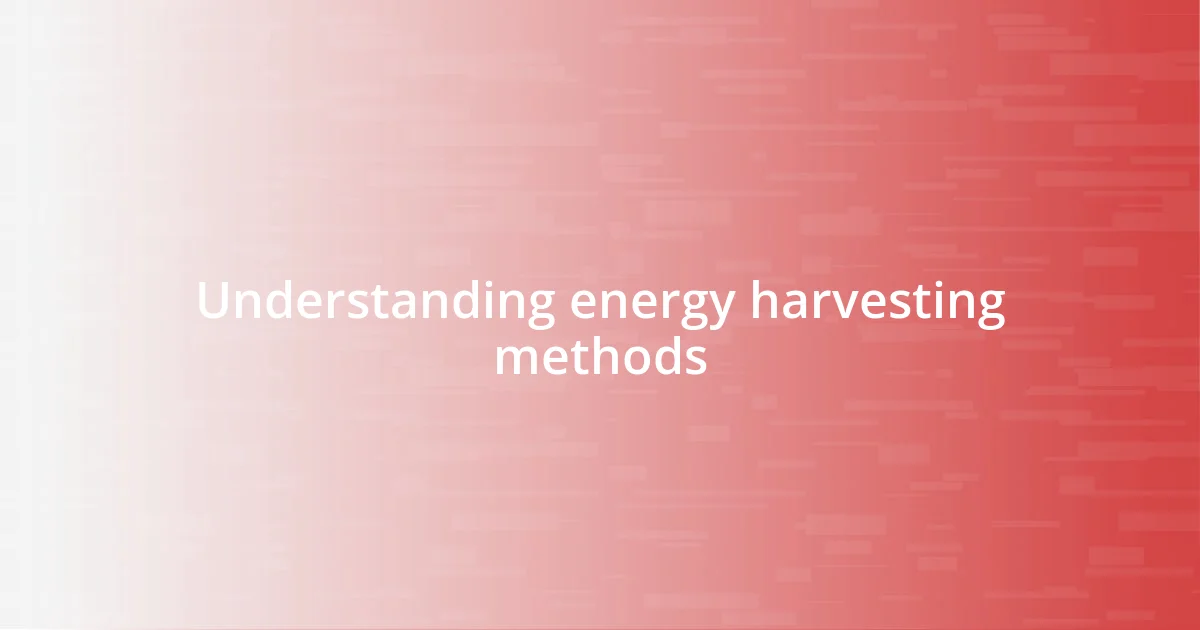
Understanding energy harvesting methods
Energy harvesting methods can be so fascinating when you dive into the different techniques available. For instance, I’ve always been intrigued by how piezoelectric materials convert mechanical stress into electrical energy. Imagine walking across a floor that generates power simply from your footsteps—it’s like a dance with technology, bringing together movement and energy in harmony.
I’ve had moments watching small devices powered by solar energy in my garden. It made me realize how sunlight can be harnessed so effortlessly, turning an ordinary day into a source of power. Isn’t it remarkable that something as simple as sunlight can fuel so many devices? This method, along with thermoelectric generation, shows us just how much potential resides in the natural processes around us, often going unnoticed.
On a broader scale, we’re beginning to tap into ambient energy harvesting. Picture this: small sensors collecting energy from radio frequency signals in our environment to power smart devices. It’s both exciting and a bit overwhelming to think about how interconnected our lives are becoming through these innovations. How do you feel about living in a world where even the smallest bits of energy can be utilized? It’s like we’re truly redefining how we generate and consume energy, making our lifestyle both smarter and more sustainable.
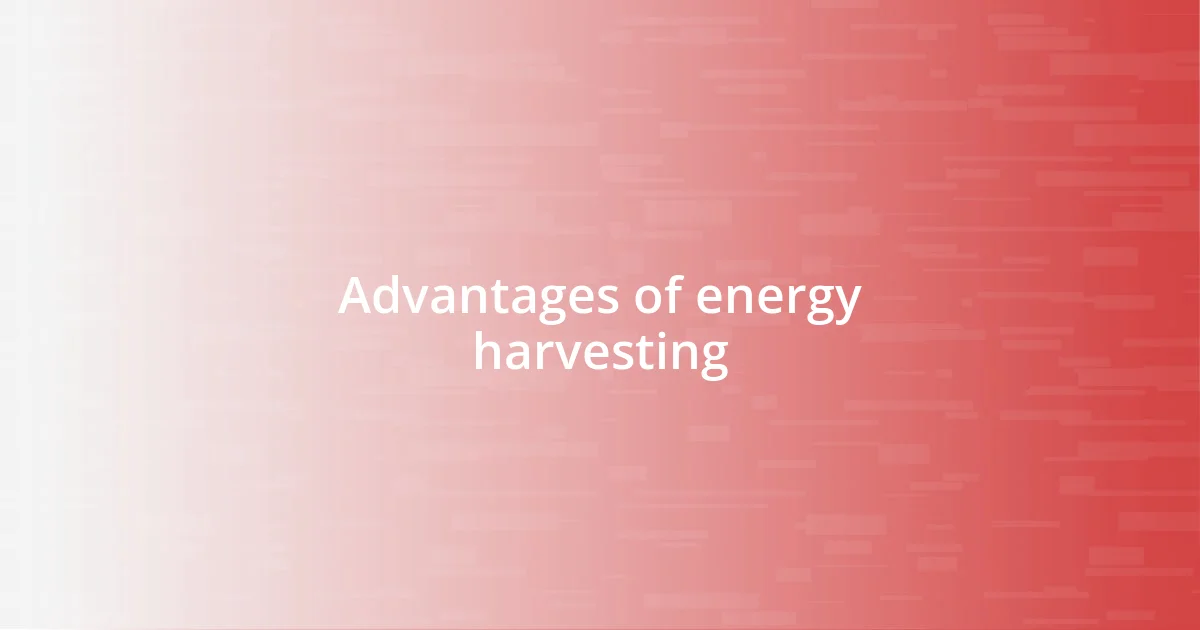
Advantages of energy harvesting
The advantages of energy harvesting are vast and can genuinely reshape the way we think about power. For instance, I remember my initial excitement when I came across a wearable device that generated energy from my body’s movement. It made me appreciate how convenient and self-sufficient technology can become. This not only diminishes the reliance on traditional power sources but also paves the way for a sustainable future.
Here are some key advantages of energy harvesting:
- Sustainability: Reduces dependency on fossil fuels, promoting a cleaner environment.
- Energy Efficiency: Captures energy from already existing sources, making systems more efficient.
- Cost-Effectiveness: Lowers energy bills and decreases maintenance costs over time.
- Autonomy: Allows devices to operate independently, enhancing functionality without needing frequent charging.
- Reduced Environmental Impact: Contributes to minimizing waste and pollution associated with conventional energy sources.
Reflecting on how small innovations can lead to significant changes has always been inspiring to me. I believe that each step toward harnessing energy from our everyday environments brings us closer to a future where technology and sustainability go hand in hand.
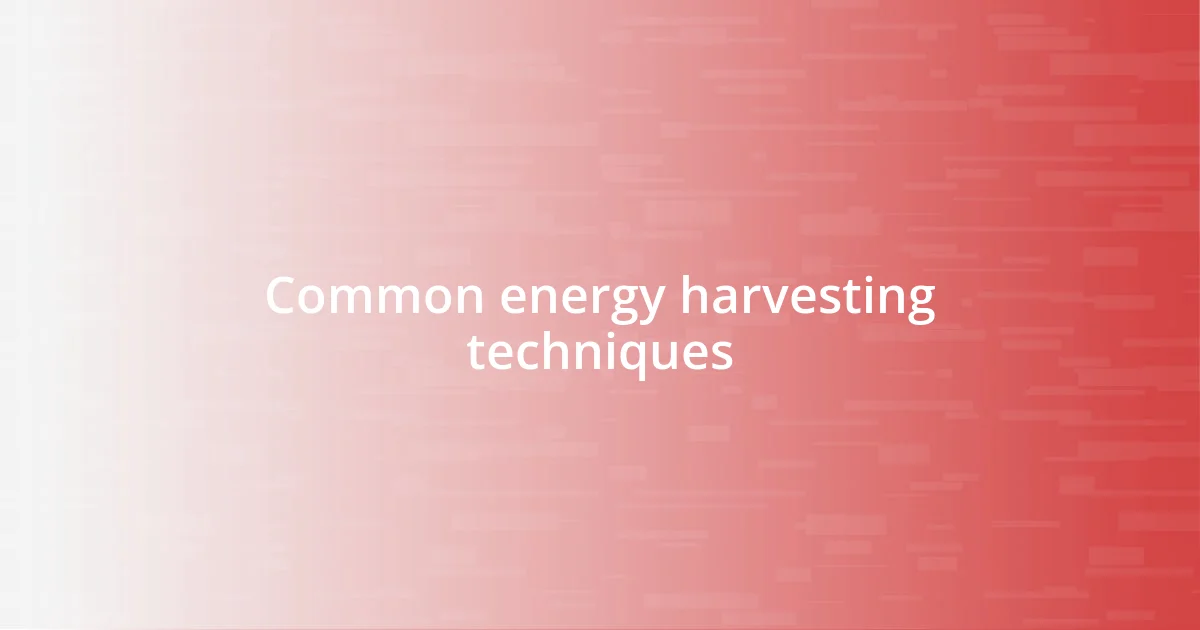
Common energy harvesting techniques
When exploring common energy harvesting techniques, I find it fascinating how versatile these methods can be. For instance, wind energy harvesting can be as simple as a small turbine in your backyard. I remember my neighbor installed one, and I was amazed at how it powered their shed lights just from those gentle breezes—all without disturbing the tranquility of the garden.
Another common technique is thermoelectric energy harvesting, where heat differences are converted into electrical energy. Some time ago, I visited a demonstration where they used heat from cooking appliances to generate electricity—what an eye-opening experience! It made me appreciate the untapped potential of everyday heat sources in our homes.
Lastly, solar energy is unmatched in its accessibility and efficiency. I once experimented with a small solar panel kit, powering garden lights. The thrill of seeing them glow at dusk, fueled by sunlight from earlier in the day, felt like a small victory in my personal sustainability journey. These experiences remind me how crucial it is to embrace energy harvesting in our lives.
| Technique | Description |
|---|---|
| Wind Energy Harvesting | Captures wind movement to generate electricity using turbines. |
| Thermoelectric Energy Harvesting | Converts heat differences into electrical energy, often using temperature gradients. |
| Solar Energy Harvesting | Absorbs sunlight using panels or cells to generate electricity. |
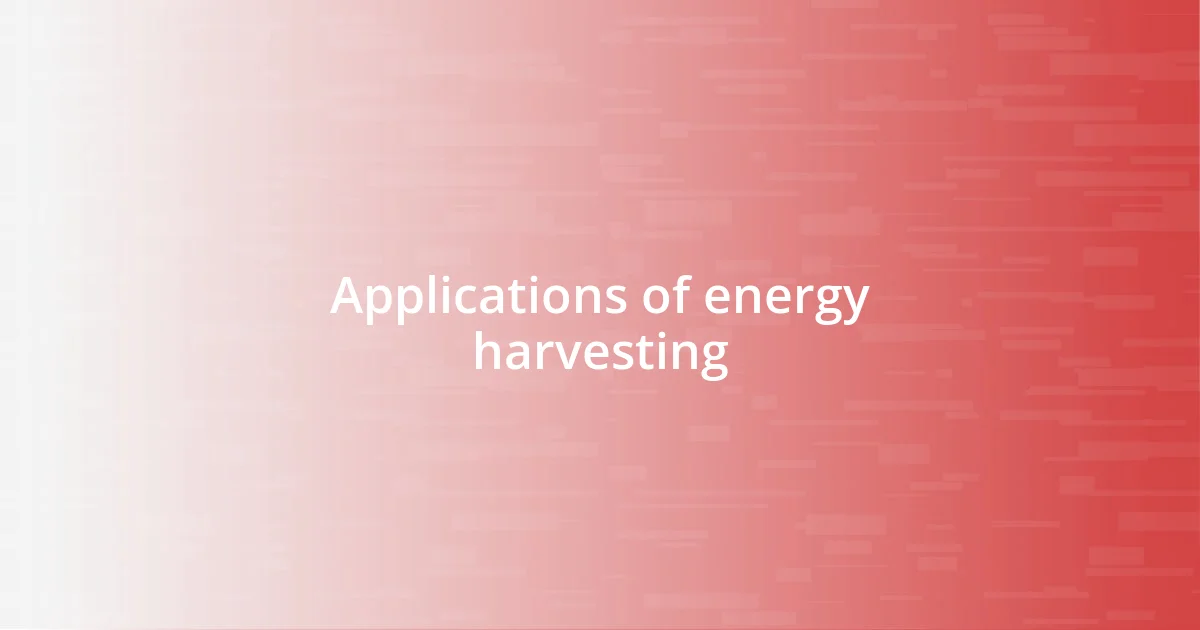
Applications of energy harvesting
Energy harvesting finds exciting applications across various fields, each revolutionizing how we interact with technology. For example, I recently attended a conference where a company showcased self-powered sensors embedded in roads that gathered data without needing external power. Imagine how incredible it is to think that our infrastructure can be enhanced without the constant drain on power supplies. It got me wondering about the future of smart cities—could they operate entirely on harvested energy?
In wearable technology, I’ve seen firsthand how energy harvesting can change the game. A friend of mine uses a smart watch that charges itself through motion. The idea that she captures energy simply by going about her day is revolutionary! It made me realize how such advancements can enhance our lifestyle while reducing environmental footprints. Have you ever thought about how much energy we waste each day?
Moreover, energy harvesting is taking root in agriculture too, particularly through soil moisture sensors that help optimize irrigation. Last summer, while visiting a family farm, I encountered systems leveraging harvested energy to monitor crops. This not only conserves water but also ensures better yields. It’s moments like these that reinforce my belief in the power of innovation. It’s not just about generating energy; it’s about reshaping entire industries and positively impacting our lives and the planet.
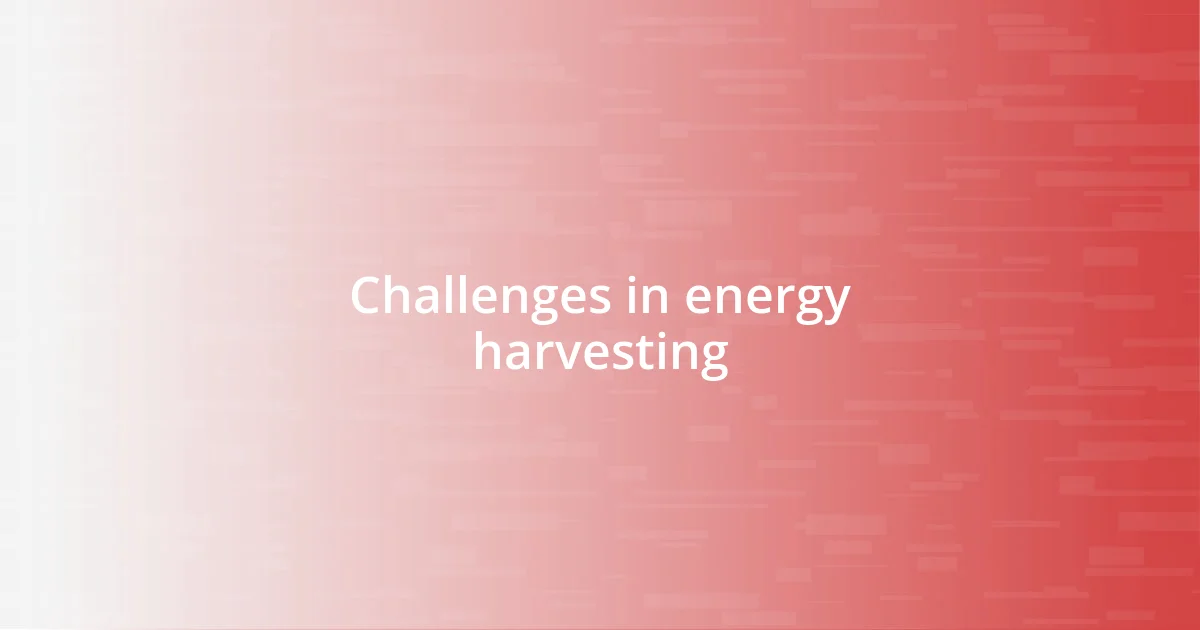
Challenges in energy harvesting
One significant challenge in energy harvesting is the efficiency of conversion. Often, the amount of energy harvested is much lower than expected. I recall a project where I attempted to use piezoelectric materials to capture energy from footsteps. While it sounded promising, the actual energy generated was minimal. It made me wonder—how can we improve these systems to make them more effective?
Another obstacle is the variability of energy sources. For instance, when I installed a small wind generator, I was thrilled by the prospect of harnessing energy from the breeze. But there were days of calm where it simply didn’t produce anything. This unpredictability can make relying solely on harvested energy challenging, fostering a sense of frustration. Have you ever felt like your renewable efforts were hampered by the weather?
Finally, the integration of energy harvesting systems into existing infrastructures can be daunting. I once visited a smart building that integrated solar panels and kinetic tiles with its electricity system. While it was impressive, I saw firsthand the complexity involved in merging new technology with old frameworks. It left me pondering: how do we strike a balance between innovation and practicality in our quest for sustainable energy solutions?
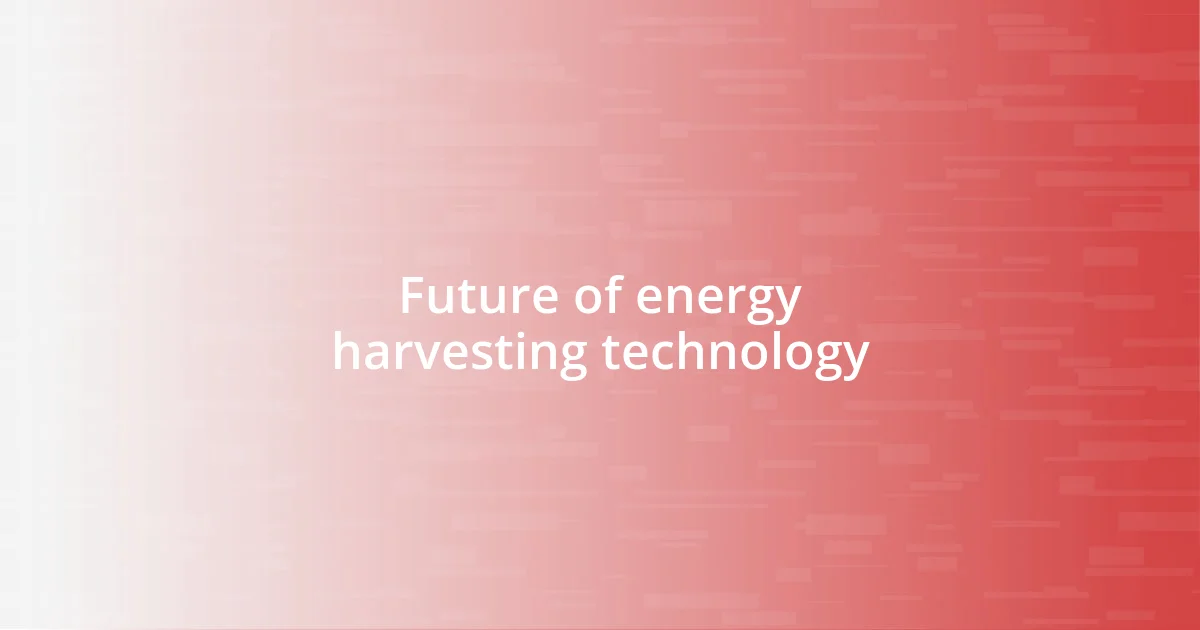
Future of energy harvesting technology
The future of energy harvesting technology is incredibly promising and filled with potential. Just the other day, I found myself daydreaming about how advancements in materials science could lead to even more efficient solar cells. Imagine if these cells could capture energy not only from sunlight but also from ambient heat! It’s astonishing to think of homes and buildings becoming energy-neutral or even energy-positive. Wouldn’t it be fantastic to live in a place where your energy bills evaporate, all thanks to innovative harvesting techniques?
As I reflect on the future, I can’t help but feel excited about the role of nanotechnology in energy harvesting. I once read about tiny piezoelectric devices that could be integrated into clothing. The idea that our clothes could generate power while we move is incredible! Picture yourself wearing a shirt that recharges your phone throughout the day. It’s almost like science fiction merging with reality. Do you ever wonder what it would be like to be completely unconcerned about battery life?
Looking ahead, we also need to address how societal and regulatory frameworks will evolve alongside this technology. After attending a recent workshop on energy policy, I was struck by the potential for government incentives to bolster research and development in energy harvesting. If we can create a supportive environment that encourages innovation, the sky’s the limit! What obstacles do you think we still need to overcome for a widespread adoption of these techniques? By fostering a culture of creativity and collaboration, we can reshape our energy landscape into something more sustainable and efficient.













